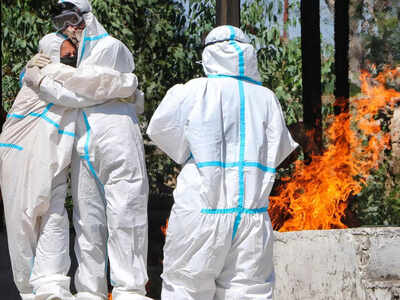Top Searches
- News
- City News
- noida News
- Nearly 50% of Covid deaths in Noida, Ghaziabad in first half of May
Nearly 50% of Covid deaths in Noida, Ghaziabad in first half of May

Of the 392 deaths reported in Noida since March last year, 180 were added between May 1 and 16 (PTI file photo)
NOIDA: The number of deaths reported in the just the first half of this month accounts for almost half the overall Covid death toll, both in Noida and Ghaziabad.
Of the 392 deaths reported in Noida since March last year, 180 were added between May 1 and 16. According to government data, the first half of May accounted for 46% of the total number of deaths in the district. The figure accounts for only those deaths that were notified by hospitals as Covid fatalities.
With 121 deaths, April saw 31% of the total deaths. In fact, the period between April 1 and May 16 accounts for 77% of the all Covid deaths in Noida. Between March 2020 and March 2021, the district recorded 91 fatalities.
Similarly, in Ghaziabad, 74% of the total Covid deaths in the district were reported between April 1 and May 16. In the first 16 days of May, 169 deaths were recorded. The overall death toll in Ghaziabad is 375 and the fatalities recorded between May 1 and May 16 makes up 45% of that. From March 2020 to March 2021, the district reported 102 deaths.
“The data is self-explanatory. It clearly shows the severity of the infection in April and the first half of May,” said an official in the Ghaziabad health department. “There are 14-15 days left for this month and the district is reporting deaths daily. If the trend continues, the death count for this month may go past the 200 mark,” the official added.
Explaining the current trend, Brigadier Dr Rakesh Gupta (retd), director, Government Institute of Medical Sciences (GIMS) in Greater Noida, said: “ This time, we are noticing that for some patients, the condition is deteriorating suddenly. The oxygen saturation level drops suddenly after a few days of infection and then it becomes difficult to manage the patient.”
Of the 392 deaths reported in Noida since March last year, 180 were added between May 1 and 16. According to government data, the first half of May accounted for 46% of the total number of deaths in the district. The figure accounts for only those deaths that were notified by hospitals as Covid fatalities.
With 121 deaths, April saw 31% of the total deaths. In fact, the period between April 1 and May 16 accounts for 77% of the all Covid deaths in Noida. Between March 2020 and March 2021, the district recorded 91 fatalities.
Similarly, in Ghaziabad, 74% of the total Covid deaths in the district were reported between April 1 and May 16. In the first 16 days of May, 169 deaths were recorded. The overall death toll in Ghaziabad is 375 and the fatalities recorded between May 1 and May 16 makes up 45% of that. From March 2020 to March 2021, the district reported 102 deaths.
“The data is self-explanatory. It clearly shows the severity of the infection in April and the first half of May,” said an official in the Ghaziabad health department. “There are 14-15 days left for this month and the district is reporting deaths daily. If the trend continues, the death count for this month may go past the 200 mark,” the official added.
Explaining the current trend, Brigadier Dr Rakesh Gupta (retd), director, Government Institute of Medical Sciences (GIMS) in Greater Noida, said: “ This time, we are noticing that for some patients, the condition is deteriorating suddenly. The oxygen saturation level drops suddenly after a few days of infection and then it becomes difficult to manage the patient.”
FacebookTwitterLinkedinEMail
Start a Conversation
end of article
Top Stories Right Now
- indiaCovid-19: Very little of 25% vaccination quota for private hospitals flowing to ...
- indiaClot cases post-Covishield jab miniscule: Govt panel
- indiaIndia 2nd after US to cross 25 million Covid cases
- cityLive: Cyclone Tauktae eye landfall completes, weakens after in Gujarat
- indiaCovishield 2nd dose appointments cancelled in some states
